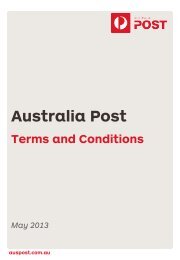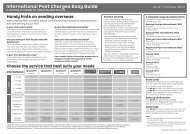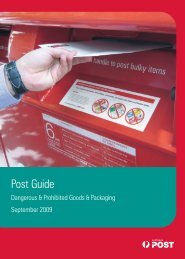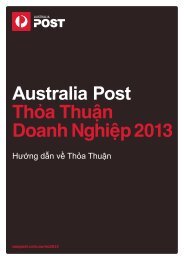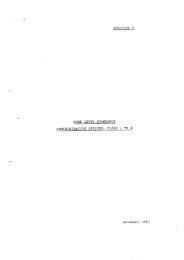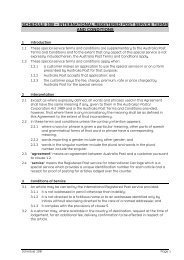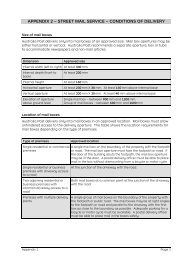Australia Post Annual Report 2008–09
Australia Post Annual Report 2008–09
Australia Post Annual Report 2008–09
You also want an ePaper? Increase the reach of your titles
YUMPU automatically turns print PDFs into web optimized ePapers that Google loves.
Notes to and forming part of the Financial <strong>Report</strong> for the year ended 30 June 2009<br />
29 Financial and capital risk management (continued)<br />
(c) Categories of financial instruments<br />
Financial assets<br />
Loans and receivables (including cash and cash equivalents)<br />
Derivative instruments in designated hedge accounting relationships<br />
Financial liabilities<br />
Other financial liabilities at amortised cost<br />
Other financial liabilities designated in fair value hedge<br />
relationships at amortised cost and adjusted by<br />
the gain/loss attributable to interest rate risk<br />
Derivative instruments in designated hedge accounting relationships<br />
Financial guarantee contracts<br />
100<br />
<strong>Australia</strong> <strong>Post</strong> <strong>Annual</strong> <strong>Report</strong> <strong>2008–09</strong> | Financial and statutory reports<br />
2009<br />
$m<br />
1,285.8<br />
9.8<br />
626.5<br />
541.7<br />
20.1<br />
0.1<br />
Consolidated Corporation<br />
2008<br />
$m<br />
1,425.7<br />
0.0<br />
640.4<br />
514.2<br />
15.7<br />
0.3<br />
2009<br />
$m<br />
1,251.4<br />
9.8<br />
(d) Net gain or loss on loans and receivables and financial liabilities measured at amortised cost and<br />
held-to-maturity investments<br />
The net gain or net loss on the loans and receivables category of financial instruments (including cash and cash equivalents) is determined<br />
as interest revenue, plus or minus foreign exchange gains or losses arising from the revaluation of the financial asset and minus any impairment<br />
recognised in profit or loss as shown below.<br />
Interest revenue (see note 2)<br />
Foreign exchange gain/(loss)<br />
Impairment loss (see note 3)<br />
2009<br />
$m<br />
34.4<br />
6.2<br />
(0.8)<br />
606.8<br />
541.7<br />
20.1<br />
0.1<br />
2008<br />
$m<br />
1,413.5<br />
0.0<br />
625.2<br />
514.2<br />
15.7<br />
0.3<br />
Consolidated Corporation<br />
2008<br />
$m<br />
48.6<br />
(8.6)<br />
(0.4)<br />
2009<br />
$m<br />
35.6<br />
6.2<br />
(17.9)<br />
Net gain on loans and receivables 39.8 39.6 23.9 40.3<br />
The net gain or net loss on financial liabilities measured at amortised cost is determined as interest expense, plus or minus foreign exchange gains<br />
or losses arising from the revaluation of financial liabilities measured at amortised cost as shown below.<br />
Interest expense (see note 4)<br />
Foreign exchange gain/(loss)<br />
2009<br />
$m<br />
34.6<br />
4.7<br />
2008<br />
$m<br />
50.1<br />
(8.6)<br />
(1.2)<br />
Consolidated Corporation<br />
Net loss on financial liabilities measured at amortised cost 39.3 27.2 39.0 26.6<br />
(e) Market risk<br />
The corporation’s and the group’s activities expose it primarily to the financial risks of changes in foreign currency exchange rates (see note 29(f)),<br />
commodity prices (see note 29(g)) and interest rates (see note 29(h)). The corporation is a party to derivative financial instruments in the normal<br />
course of business in order to hedge exposure to fluctuations in foreign exchange rates, commodity prices and interest rates. Reference should also<br />
be made to note 1(m) relating to derivative financial instruments. At a corporation and group level, market risk exposures are managed through<br />
sensitivity analysis and stress scenario analysis.<br />
2008<br />
$m<br />
33.0<br />
(5.8)<br />
2009<br />
$m<br />
34.0<br />
5.0<br />
2008<br />
$m<br />
32.8<br />
(6.2)




